In this issue
Air permitting e-Services update
This winter, the Minnesota Pollution Control Agency (MPCA)
plans to launch a new electronic service that will allow facilities to submit applications
for individual air permit reissuances online. As of October, all individual air
permit administrative amendment applications could be submitted by
e-Service. The MPCA encourages, but does not require, facilities to use e-Services
to submit these amendment applications.
Benefits
The new e-Service will make permitting reviews faster by
streamlining processes and decreasing data entry. It will help populate
the database of permitting data that reduces the time required to issue air
quality permits.
Getting started
First-time users of air quality e-Services should go to the
MPCA’s Air
permit forms and online submittals webpage for help getting started.
The forms page has links to all available air e-Services, instructions on
setting up an account and getting facility access, and a list of information
needed for each page in the application. The page currently lists the available
e-Services and help content. Additional links will be added for the new service
prior to going live. Once in the e-Service, users will have access to help
files for every page and field. If the help pages do not provide the
information needed, users should contact the MPCA at onlineservices.pca@state.mn.us.
An e-services account can be created before the new Service
goes live. Existing users of air e-services will be able to use the same
account they already created to submit individual air permit reissuance
applications.
Update to standards of performance for stationary
internal combustion engines – ultra-low sulfur fuel requirement
Earlier this year, the MPCA finalized adoptions and
revisions to rules governing air quality in multiple Minnesota Rules Chapters as
part of its Omnibus
Air Rule Amendments. The new rules updated these chapters to keep
Minnesota’s air quality rules current and ensure consistency with applicable
state and federal regulations. The changes were effective December 27, 2016.
As part of the omnibus rulemaking, the MPCA lowered the
sulfur dioxide emissions limit for internal combustion engines to 0.0015 pounds
per million Btu. This change reflects the widespread availability of ultra-low
sulfur fuels that can meet this limit. It also responds to the new, more
stringent one-hour National Ambient Air Quality Standard (NAAQS) for sulfur
dioxide recently promulgated by the U.S. Environmental Protection Agency (EPA).
This new limit is effective January 31, 2018.
For facilities that wish to maintain their fuel flexibility,
the rule change allows alternate fuels at facilities if they can demonstrate
compliance with the sulfur dioxide NAAQS and their current permit contains the
limitations needed to demonstrate compliance. The MPCA recognizes that some
facilities in the state still use higher-sulfur fuels as a backup fuel source.
These facilities will be able to continue to use these higher-sulfur fuels if
they obtain a permit to do so.
Updated Air
Quality Dispersion Modeling Practices Manual and AQDM forms now available
The 2017 revised MPCA Air Quality Dispersion Modeling
Practices Manual is now available on the MPCA’s Air Quality Dispersion Modeling working practices and
policies webpage. The manual is
effective as of October 2017 and reflects updates to current modeling practices
based on feedback received on the draft copy of proposed changes, changes to EPA’s
Appendix W, and the full transition to MPCA’s e-service online delivery system.
Also available are updated Air Quality Dispersion Modeling (AQDM) forms, which
are located on the AQDM forms webpage.
Thank you to everyone who provided input on our proposed
2017 manual changes! Comments received help improve MPCA’s modeling and review
processes. If you have thoughts, comments, or related feedback throughout the
year, please send us a message at AirModeling.PCA@state.mn.us.
Update to
Minnesota’s Prevention of Significant Deterioration (PSD) program
As of October 26, 2017 (published in the Federal
Register on September 26, 2017), Minnesota is now operating a State
Implementation Plan-approved PSD program.
Until now, Minnesota has issued PSD permits under a delegation of
authority through EPA’s program. The
Clean Air Act intends for states to implement their own PSD programs, so
getting Minnesota’s PSD program approved into the SIP aligns us with the
intention of the Act.
The MPCA submitted Minnesota’s existing PSD rule (Minn. R. 7007.3000)
for approval into our SIP. Because we
submitted our current rule for EPA approval, there are few substantive changes
to the program. The slight differences
in program implementation include:
-
Under the federally delegated program, appealed permit decisions went
to the federal Environmental Appeals Board (EAB). With a SIP-approved PSD program, appeals
will go to the state contested case hearing process.
- As a result, there is no longer an EAB appeal period after a final
permit is issued.
- Consultations for the Endangered Species Act and Historic Preservation
Act are no longer required because PSD permits will no longer be federal
actions. However, the requirements of
these laws do still apply.
Changes to the PSD program will continue to be adopted as
they become effective under the federal rule (40
CFR 52.21).
If you have questions on Minnesota’s PSD program, please
contact Dick Cordes, P.E. (651-757-2291 or richard.cordes@state.mn.us).

With the installation of new charging stations, you can now
travel by electric vehicle (EV) from the Twin Cities metro area to Duluth. Interstate
35 now has a series of fast-charging stations that can charge an EV in about 30
minutes. Forest Lake, Pine City,
Sturgeon Lake, and Duluth all host stations.
EV drivers can travel with confidence knowing an opportunity to charge
is not far away. Plans are in the works
for additional charging stations beyond Duluth to allow eventual travel by EV
along the North Shore.
|
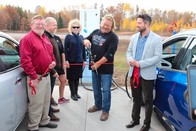
In October, the final link in Minnesota’s first EV “charging
corridor” was completed with the opening of the Sturgeon Lake station. Representatives from project partners –
MPCA, ZEF Energy, Lake Country Power, Great River Energy, and Doc’s Sports Bar
& Grill (where the station is located) – were on hand to mark the occasion.
|

This spring Minnesota Power installed a 54-kilowatt solar
carport along with charging stations in Canal Park in Duluth. The carport hosts eight Level 2 stations that
can charge an EV in 2 to 6 hours and one fast charging station that can charge
an EV in 30 minutes. Electricity from
the solar array feeds directly into the charging stations when charging an
EV. Excess power is fed back onto the
grid.
Minnesota has plans for highway charging corridors that will
eventually allow drivers to travel by EV throughout the state. The U.S. Department of Energy is also
designating national charging
corridors to encourage travel by EV nationwide. To learn more about
Minnesota’s first EV charging corridor and other upcoming corridors, visit PlugIntoMN.com.
|
The MPCA
will be expanding its annual winter modeling seminar to include staff
presentations on emissions inventory and our air monitoring network .
The
meeting will be held on Thursday, January 11th, 2018 from 9:00 a.m.–4:30
p.m. in the board room of the MPCA’s St. Paul office, 520 Lafayette Road North.
Inventory and monitoring network topics, as they relate to air modeling,
will be presented in the morning and specific air modeling topics in the
afternoon.
This
seminar is an opportunity for participation by the regulated community. We are soliciting external stakeholders to give
presentations relating to air modeling, inventory, and monitoring topics. Please send an email to AirModeling.PCA@state.mn.us to propose a specific presentation. Further details about this meeting will be sent in a future Air
Mail Bulletin.

The MPCA is committed to making sure that pollution does not
have a disproportionate impact on any group of people — the principle of
environmental justice. This means that
all people — regardless of their race, color, national origin, or income —
benefit from equal levels of environmental protection and have opportunities to
participate in decisions that may affect their environment or health.
The MPCA’s approach to integrating environmental justice
into its work, as outlined in our Environmental Justice Framework, begins with
an assessment of where low-income Minnesotans, people of color, and others may
be experiencing more harm or may be more susceptible to environmental
conditions.
To aid in this process, and only as an initial step, the
MPCA uses demographic data to identify census tracts that may be areas of
elevated concern for environmental justice issues. Specifically, an area of
concern for environmental justice is a census tract that meets one or more of
these criteria:
-
The
number people of color is greater than 50%.
- More
than 40% of the people have an income of less than 185% of the federal poverty
level.
- Additionally,
the MPCA considers communities within tribal boundaries as areas of concern.
The MPCA has developed an online
screening tool to allow staff, the people we regulate, our partners, and
community members to identify areas where additional consideration or effort is
warranted to evaluate the potential for disproportionate adverse impacts,
consider ways to reduce those impacts, and ensure meaningful community
engagement.
Examples of how the MPCA is using this screening tool in
the air program include:
-
Targeting grants and technical assistance to
reduce air emissions from sources located in these areas.
- Including environmental justice concerns and
increased air pollution concentrations as a criterion when selecting which
facilities to inspect.
- During air permitting, involving community
members earlier in the permitting process and looking for ways to strengthen
established permit limits or change practices to diminish impacts.
- Consider prioritizing review and evaluation of
expired permits for facilities located in areas of concern.
To learn more about the MPCA’s work towards environmental
justice, visit our website.
|
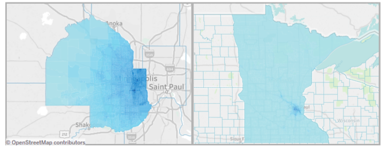
The
results of a statewide air modeling effort using Minnesota’s 2011 emission
inventory are now available on the MPCA website. Users can explore interactive
maps to see statewide and local air
pollution
modeling results
for fine particles and pollutants known as air toxics.
Use the pollutant priority tool to:
-
Explore potential health risks due to
air pollution in your community
-
Compare the health risks of pollutants
between different cities and communities.
Use the source priority tool to:
-
Identify primary sources of fine
particles and air toxics in your city or community
- View the impact of busy roads and other
sources on pollutant concentrations near you
- Compare health risks in areas of
environmental justice concern.
Visit the MPCA’s air modeling and human health webpage to start exploring air pollution in
Minnesota.
|
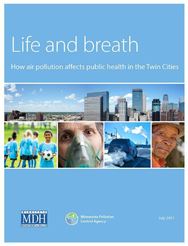
In 2015, the MPCA and Minnesota Department of Health
released the Life
and Breath report on the health impacts of air pollution in the Twin Cities
metropolitan area. This report was part
of a larger collaboration between the two agencies to study and inform the
public and other stakeholders about the health impacts of air pollution. The BeAirAwareMN.org
website was another key product of this joint initiative.
This summer, the MPCA and MDH completed additional analyses
with more recent (2012) air quality and health data to update the estimates of
air pollution-attributable deaths in the Twin Cities metro area and included
these results in a new appendix in the report.
Additionally, the authors of the report published an article in the
September/October issue of the Journal
of Public Health Management and Practice describing the collaboration, how
the study was done, and key results.
This helps to inform a broader public health audience about the
relationship between air pollution and health.
Now, the two agencies are working to extend the Life and
Breath analysis statewide. Including greater
Minnesota is an important next step for characterizing the health impacts of
air pollution for all Minnesotans. The
findings of the statewide analysis will be used to build broader awareness
about the health impacts and risks of air pollution, identify vulnerable
populations and areas, and inform pollution prevention and health promotion
policies and actions at both state and local levels. You can expect to see the report by late
2018.
|
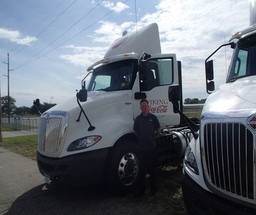
The MPCA will soon have
$200,000 available to fund projects that take old diesel vehicles and equipment
out of commission and replace them with new, less-polluting versions. We expect the 2018 Diesel Emission Reduction
Act grant will be open by the end of November.
All application materials will be found on our Clean
Diesel website. There you can also
find examples of past projects that received funding. Watch for an Air Mail announcement when the
grant is posted.
The MPCA recently finished administering the
2017 round of clean diesel grants, which replaced 17 old diesel engines. Projects included a crane, a commercial boat,
and 11 trucks. These projects reduced emissions of fine particles and nitrogen
oxides by about 95 percent
|

Older diesel engines produce substantial amounts of
particulate pollution which can work their way through the lungs and into the
circulatory system. The particles cause increased risk of heart attacks,
strokes, and asthma attacks. Diesel exhaust also contains nitrogen oxides,
a major pollutant which can aggravate respiratory conditions such as asthma. New
heavy-duty engines are significantly cleaner than older versions, so replacing
these old trucks and equipment with new models results in major emissions
reductions.
|
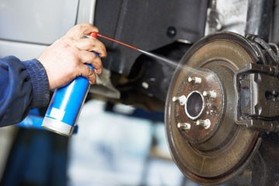
This summer, automotive shops in Minneapolis’s
Phillips neighborhood got an opportunity
to improve worker safety and public health by switching to safer cleaning and
degreasing products. Standard cleaning and degreasing products emit hazardous
air pollutants (HAPs) and volatile organic compounds (VOCs), which contribute
to poor air quality. To address these common pollutants, the
Minnesota Technical Assistance Program (MnTAP) developed an intern project to provide
technical assistance to auto shops to promote adoption of safer cleaning and degreasing
products.
After identifying interested
businesses, the MnTAP intern
analyzed the products in use at the shop, provided samples of cleaner
alternatives, and worked with owners on their use. If the shop mechanics liked
the products and agreed to change, MnTAP provided a case of them to encourage
the switch. As a result, participating shops will cut over 450 lbs. of VOCs and
860 lbs. of HAPs emissions annually.
This
winter MnTAP is expanding the program to facilities in North
Minneapolis. To learn more or participate in this program contact Jane Paulson (612-624-1826,
janep2@umn.edu).
Next summer, interns will continue working in local
communities to address air quality by improving energy efficiency, water
conservation, and waste reduction through pollution prevention. Focus areas
include food processing and water savings, or any other environmental challenge
a host business may have. To learn more about the Intern Program and how to
apply for a 2018 MnTAP intern, contact Nathan Landwehr, Intern Administrator (612-624-4697 or landw021@umn.edu),
or visit MnTAP’s website.
|
From food trucks to cell phone charging, the 2018 Super Bowl
will rely on many temporary generators to meet its energy needs. To help
prevent undue air pollution from their use, the MPCA and our partners on the
2018 Super Bowl Host Committee Sustainability Team, helped develop a Guide to
Selecting Generators and Stationary Engines: Smart Choices can Minimize Impacts.
The Guide contains emissions information and identifies best management
practices for generators and engines. Aside from the Super Bowl, the guide can
be used for any event that might use generators or engines for power
generation.
The guide is a collaboration between the MPCA, Xcel Energy,
the City of Minneapolis and Ecolab, with support from the Minnesota Department
of Commerce and the Metropolitan Council. Find it and other energy tips on the
MPCA’s website.

On October
2, 2017, the parties in the Volkswagen
settlement negotiation filed the final, signed documents with the court. You can find the final settlement documents here. On November 6, 2017, Minnesota submitted our
paperwork to officially become eligible to receive our $47 million allocation.
The
MPCA will soon be hosting additional public meetings around the state to hear
more from Minnesotans on what matters to them and what types of projects are
most important to them. The funds can be
used for projects that replace old heavy-duty diesel equipment and vehicles
with new equipment or to install electric vehicle charging stations. We have not yet finalized meeting dates and
times. Watch for an announcement in the
coming weeks.
To keep
up to date on the Volkswagen settlement in Minnesota, sign up for our email
list here.
|
On November 6, 2017, EPA announced designations for most of
the country for the 2015 ozone National Ambient Air Quality Standards
(NAAQS). All counties in Minnesota were
designated “attainment/unclassifiable.” This designation means that monitoring
data indicate that Minnesota is complying with the ozone NAAQS.
The Clean Air Act requires EPA to review national air
quality standards for common air pollutants every five years to ensure they
reflect the most current scientific evidence and are protective of human health
and the environment. EPA must then work
with the states to determine what parts of the country are complying with the
standards (attainment), not complying with the standards (nonattainment), or
unclassifiable.
Learn more on EPA’s website.
Clean Power Plan
repeal
On October 16, 2017 the EPA proposed to repeal the Clean
Power Plan. The Clean Power Plan is an
Obama administration regulation that requires states to reduce carbon dioxide
emissions from their power sectors. The
new administration is proposing to repeal this rule and says they may consider
a replacement in the future, but has not set a specific timeline. Read more at the New
York Times and on the EPA’s website.
Review of vehicle
greenhouse gas emissions standards
On August 21, 2017 the EPA announced a reconsideration of
the federal fuel efficiency and greenhouse gas emission standards for passenger
vehicles that were set to come into effect in 2021-2025. Learn more on the EPA’s website
and at Automotive
News.
Air Mail is a quarterly,
email-based newsletter featuring updates on air quality issues and the work of
the MPCA and our partners. Subscribers to this list also receive Air Mail
Bulletins, which provide time-sensitive regulatory and technical updates.
To see past issues, Air Mail
Bulletins, or to subscribe, visit the MPCA's website.
If you have questions
or comments about Air Mail, please feel free to contact Amanda Jarrett Smith at
amanda.smith@state.mn.us.
|











